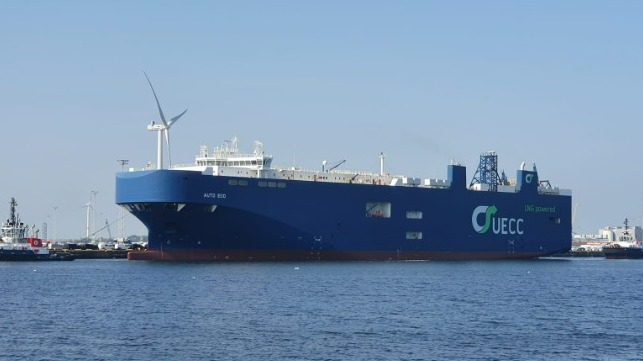UECC's Green Fleet Making a Difference for Environment & Bottom Line

[By: UECC]
UECC has made big strides in cutting the carbon intensity of its vessels by taking a proactive approach to fleet renewal and experimenting with alternative fuels - but still sees a lack of market understanding of the long-term value of green logistics.
“Money still talks loudest in the shipping industry and unfortunately the freight rate remains the overriding factor for many of the car manufacturers when selecting a cargo carrier, regardless of the environmental footprint of the logistics solutions,” says UECC chief executive Glenn Edvardsen.
The European shortsea ro-ro car carrier has led the way in sustainable fleet operations after bringing onto the water the world’s first dual-fuel LNG pure car and truck carriers (PCTCs) five years ago and is now reaping the fruits of its efforts in significantly reduced emissions.
These two vessels, Auto Eco and Auto Energy, are already compliant with the IMO’s goal to cut carbon intensity from shipping by 40% within 2030 due to significant reductions in CO2 and NOx emissions, and effective elimination of sulphur oxide and particulate emissions.
The company has now been listed as a finalist for the 2021 Heavy Lift Environment Award, with winners to be announced in London next month.
First-mover in LNG
By 2022, UECC will have 80% of its total lifting capacity meeting or exceeding the IMO target with delivery of three newbuild LNG battery hybrid PCTCs - the first of which is set to be delivered next month - to give it five eco-friendly ships out of a nine-vessel owned fleet, with an additional 10 chartered vessels.
UECC was a first-mover in building dual-fuel LNG car carriers when it ordered the pair in 2014 and LNG-fuelled vessels today mostly account for nearly 12% of all newbuild orders, up from 6% in 2019, according to DNV.
“We never saw this as a risk but rather a great opportunity to make a difference and reduce GHG emissions,” Edvardsen says.
UECC’s parent companies NYK and Wallenius Lines have also participated in pioneering the dual-fuel LNG solution with a series of similar LNG newbuild orders.
DNV sees LNG as the fuel of choice for newbuilds in the near term as it can reduce greenhouse gas emissions by around 25% and is widely available through an existing bunkering network, while it can be switched out with future drop-in fuels such as bio-LNG and e-LNG with even lower emissions.
Edvardsen says the trio of hybrid newbuilds will give “a big leap” in environmental performance due to an advanced energy management system to achieve fuel savings through peak shaving, as well as a more optimised hull design, for further emissions cuts.
Fuel experimentation
As well as newbuilds, UECC is looking at ways to cut emissions from its existing fleet using available alternative fuels, notably biofuel on the Autosky that has resulted in reductions of 30 million kilograms of CO2 emissions and 9000kg of sulphur oxide emissions with a similar cut in particulate matter, and a drop of 58% in carbon intensity over a 12-month period.
Energy and sustainability manager Daniel Gent says the Autosky is running carbon neutrally already and UECC is set to secure biofuel for the whole of next year for the vessel, while also looking to extend the use of the fuel to other vessels based on possible trial cargoes backed by customers.
Consequently, UECC cut the use of fuel oil in its fleet to 89% last year and expects this figure to drop rapidly going forward, while LNG and biofuel use is expected to increase to 32,000 tonnes by 2025 from 337 tonnes in 2016.
As a result, the company aims to achieve an annual cut of 34,500 tonnes in CO2 emissions by 2025, compared with 18,700 tonnes last year and 277 tonnes in 2016.
“We are constantly evaluating alternative fuels and technologies out there and, rather than waiting for the perfect solution, have taken the lead with LNG as it is the best available fuel option at present. But that doesn’t preclude using other greener fuels in future and our newbuilds are ready for these with dual-fuel engines,” Edvardsen says.
He says though that more government initiatives are needed to promote infrastructure for alternative fuels, such as that by the Netherlands to effectively subsidise expensive biofuel for Autosky.
‘Walk the talk’
UECC has also adopted fuel optimisation systems along with other measures on existing vessels, but has ruled out the use of exhaust gas cleaning systems, or scrubbers, as it believes these are ineffective in reducing emissions.
“This is not a sustainable solution as it simply dumps exhaust gases ashore or into the sea instead of polluting the atmosphere,” Edvardsen explains.
“The aim is to find a holistic fuel solution that is effective in reducing greenhouse gases, not to install technology that simply strips out sulphur.
“A scrubber retrofit means the vessel can continue using cheaper, but more pollutive, fuel. But a green newbuild will have better payback in the long run.”
Ultimately though he says customers must also take their environmental responsibility seriously and “walk the talk” by accepting a premium for green logistics - or pay a higher price farther down the road due to reputational risk in a greener world.

that matters most
Get the latest maritime news delivered to your inbox daily.
“Tackling climate change is too big a challenge for one organisation to fix alone. Radical carbon reduction throughout supply chains is an absolute necessity,” he says.
“Only a few far-sighted customers have understood the need for green logistics amid growing pressure from regulators, consumers and finance institutions that will change the market playing field in future.”
The products and services herein described in this press release are not endorsed by The Maritime Executive.
